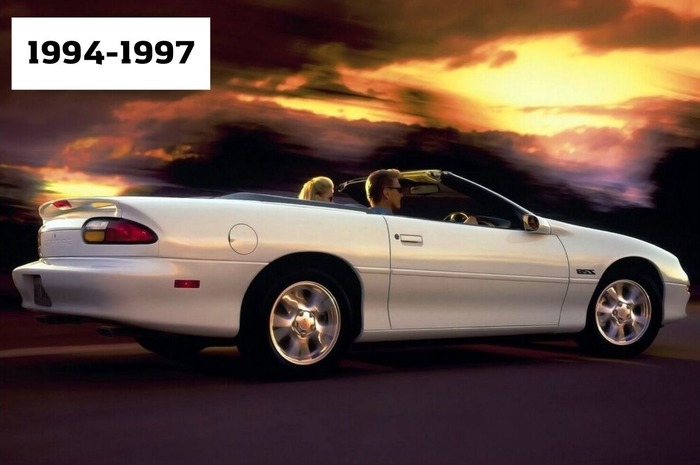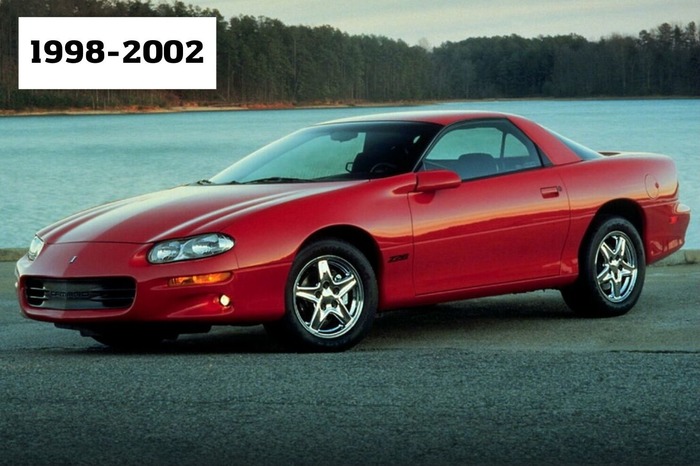
The Chevrolet Camaro is one of America’s historical automobiles with its 4th generation models (1993-2002) as one of the most stunning in the history of automobile designs. But did you know that the 4th generation legend did not have a universal base weight as may be erroneously suggested on the internet?
This piece highlights the main specs of the 4th generation Camaro and specifically identifies the weight and top speed of each single year model.
At the end of this post, you will know the exact weight of each model of the 4th generation Camaro and other impressive specs.
Main Specs
The 4th generation Chevrolet Camaro produced by General Motors retained characteristics of the first generation, such as the 2+2 seating, rear-wheel drive, and a choice between V6 and V8 engines. The body design is a choice between the base coupe or the convertible style. They also come equipped with automatic or manual transmission (manual 6 and 5 gearboxes or automatic 4 gearboxes).
Generally, the 4th generation Camaro engine power ranges from 160 hp to the frightening 310 hp of the 2002 model year convertibles. Imagine that much engine power!
As a testament to its legendary nature, The SS versions (1998-2002) received a slightly improved exhaust system, bigger wheels, and tires, a revised suspension for better handling, an arc-shaped rear wing, and different gearing ratios for better acceleration, over the Z28 models.
Chevrolet Camaro 4th-gen. Phase-I Base Coupe 1993
The 1993 Chevrolet Camaro was the first of the 4th generation models in 1993. This year's model came in Phase-I Base Coupe models and Z28 Coupe models. Although it had poor safety measures such as side and front airbags, it was undoubtedly a sparkling beauty with top-notch auto specs. Both came in coupe body types and manual and automatic transmissions alternatives.
The Z28 models' engines were 275 horsepower running at a top speed in the range of 152 to 158 miles per hour, depending on the particular year model. But the Phase-I Base coupe models' engines were only 160 horsepower running at a top speed of 130 to 132 mph depending on the model. Base curb weight for the 1993 Z28 Coupe models was between 3373 lb. and 3351 lb. The base curb weight for the 1993 Base Coupe models was 3241 lb. for the manual models and 3298 lb. for the automatic models.
Chevrolet Camaro 4th-gen. (1994-1997)

The Phase-I Base Convertible (1994-1997)
The Phase-I Base Convertible models came with both manual and automatic transmission choices with 3.4L V6 and 3.8L V6 engine choices.
The top speed of the 1994 and 1995 Phase-I Base Convertible models is 131 mph for the manual transmission models and 129 mph for the automatic transmission models. But the top speed for the Phase-I base Convertible 1996 and 1997 models is 140 mph for the manual and automatic gear models and 135 mph for only some automatic transmission models.
In terms of base curb weight, the 1994 models weigh 3399 lb. for the automatic version and 3342 lb. for the manual version. The weight of the 1995 models is 3439 lb. for the manual versions and 3515 lb. for the automatic versions. The 1996 model weighs 3439 lb. for the manual 5 gear version and 3496 lb. for all the automatic versions. The 1997 manual models weigh 3446 lb. and 3454 lb., while the automatic versions weigh 3503 lb.
The Phase-I Base Coupe (1994-1997)
The Phase-I Base Coupe models all came with manual and automatic transmission choices with a 3.4L V6 for the 1994 and 1995 models; and a 3.8L V6 engine choice for the 1996 and 1997 models. The 1994 and 1995 models of the Phase-I Base Coupe Camaro engines still maintained 160 horsepower, and all the six versions of the 1996 and 1997 Camaro's engines also offered 200 horsepower.
The top speeds for the 1994 and 1995 model versions were 132 mph for manual and 130 mph for automatic versions. For the 1996 and 1997 models, the top speed was generally 140 mph for both types of transmission versions and 136 mph for the special handling RS (Performance Handling Package Y87) versions.
The base curb weight of the 3247 lb. for the manual version and 3305 lb. for the automatic version of the 1994 Phase-I Base Coupe models. The 1995 Phase-I Base Coupe models weigh 3307 lb. for the manual versions and 3355 lb. for the automatic versions. The 1996 models also weigh 3307 lb. for the manual versions and 3364 lb. for the automatic versions.
The Phase-I Z28 Convertible (1994-199)
These models come with more powerful engines than their predecessors. The 1994 and 1995 come with more powerful engines running at 275 horsepower. For the 1996 and 1997 models, the earlier versions use 285 horsepower engines with later versions using more powerful engines with horsepower going up as much as 305 horsepower for the Z28 SS Convertible manual and automatic versions; and 310 horsepower for the Z28 SS Convertible (Performance exhaust).
The top speed for the 1994 Phase-I Z28 convertible model is 158 mph for the manual version, 152 mph for the automatic versions, and 151 mph for the automatic 3.23 axle version. For the 1995 Phase-I Z28 convertible model, the top speed for the manual version is 158 mph and 151 mph for the automatic versions.
The top speed for the 1996 Phase-I Z28 convertible model is a blazing 160 mph for the manual version, 155 mph for the automatic version, 153 mph for the automatic Performance Axle GU5 version, 155 mph for the automatic SS version, and a fiery 163 mph for the manual SS version.
The manual version of the 1997 Chevrolet Camaro Phase-I Z28 Convertible has a top speed of 160 mph, while the automatic version has a top speed of 155 mph but the top speed for the Camaro Z28 Convertible automatic Performance axle GU5 version is 153 mph. While the manual SS version of the Phase-I Z28 Convertible 1997 has a top fiery top speed of 163 mph, the automatic SS version has a 155-mph top speed. For the performance exhaust version of the Z28 SS Convertible.
For the base curb weight, the three models of the 1994 Phase-I Z28 Convertible are 3501 lb. for the manual version, 3523 lb. for the other two automatic versions. The 1995 manual version of the Phase-I Z28 Convertible weighs 3593 lb. at base curb weight, while its other two automatic versions weigh 3615 lb. each.
The base curb weights of the 1996 Z28 Convertible are 3751 lb. for the manual and 3593 lb. for the automatic, while that of the 1997 Z28 Convertible are 3589 lb. for the manual and 3611 lb. for the automatic, 3589 lb. for the manual SS version, and 3611 lb. for the automatic.
The Phase-I Z28 Coupe (1994-1997)
For the three versions of the 1994 and 1995 Phase-I Z28 Coupe, the manual versions have a top speed of 158 mph, and the automatic and the automatic 3.23 axle versions both top at the speed of 152 mph.
The Base Curb weight of the three versions is 3402 lb. for the manual version and 3424 lb. for the other two automatic versions for the 1994 model. The manual version of the 1995 model weighs 3465 lb., while its other two automatic versions weigh 3490 lb.
The 1996 and the 1997 Chevrolet Camaro Z28 Coupe came in seven versions. However, the top speed of the manual and automatic versions of the 1996 and 1997 Z28 Coupe is 160 mph and 156 mph, respectively. Both years' Z28 automatic Performance axle GU5 versions top at the speed of 153 mph, their Z28 SS versions top at 162 mph for the manual and 156 mph for the automatic.
The base curb weights of the 1996 Z28 Coupe model are 3443 lb. for the manual and 3465 lb. for the automatic, while that of the 1997 Z28 Coupe model are 3432 lb. for the manual and 3454 lb. for the automatic.
Chevrolet Camaro 4th-gen. (1998-2002)

Chevrolet Camaro 4th-gen. Phase-II Convertible (1998-2002)
All the models of the Phase-II Convertible 1998-2002 come in three versions; manual, automatic, and the automatic performance handling package Y87. The top speed for the 1998, 1999, and 2000 models is 140 mph for the manual and automatic versions and 135 mph for the automatic performance handling package Y87 version.
For the 2001 model, the top speed is 140 mph for the manual and the automatic versions and 136 mph for the performance handling package Y87 version. The 2002 model has a top speed of 140 mph for the manual, 141 mph for the automatic version, and 137 mph for the automatic performance handling package Y87 version.
The base curb weight for the 1998 model is 3468 Lb for the manual, 3525 lb. for the automatic versions. For the base curb weight of the 1999 Phase-II Convertible, the manual version weighs 3501 lb. and 3558 lb. for the automatic versions. The 2000 and 2001 models weigh 3501 lb. for the manual and 3558 lb. for the automatic versions, while the 2002 model weighs 3465 lb. for the manual and 3523 lb. for the automatic.
Chevrolet Camaro 4th-gen. Phase-II Coupe (1998-2002)
The top speed for the Phase-II Coupe 1998-2000 models is 140 mph for the manual and automatic versions and 136 mph for the automatic performance handling package Y87 versions. For the 2001 and 2002 models, the top speed is 140 mph for the manual version, 142 mph for the automatic type, 136 mph for the performance handling package Y87 versions, and 141 mph for the manual RS version, and 139 mph for the automatic RS version.
The 1998 model weighs 3381 lb. and 3393 lb. for the manual and automatic versions. The Performance Handling Package Y87 weighs 3364 Lb. The 1999 model weighs 3307 lb. and 3364 lb. for the automatic versions. The 2000 model versions all weigh 3364 lb.
The 2001 model versions all weigh 3307 lb. for the manual 3364 lb. for the automatic types, while the 2002 model versions weigh 3322 lb. for the manual and 3379 lb. for the automatic types.
Chevrolet Camaro 4th-gen. Phase-II Z28 Convertible (1998-2002)
The Phase-II Z28 Convertible 1998 and 1999 model weighs 3551 lb. with a top speed of 165 mph for the manual versions. They weigh 3576 lb. with a top speed of 162 mph/160 mph for the automatic versions. The 2000 versions weigh 3345 Lb and 3573 lb. for the manual versions. The top speed for its manual version is 164 mph and 160 mph, and 157 mph for the automatic versions.
For the 2001 and 2002 models, the top speed is 165 mph and 160 mph for the manual and automatic versions, respectively, but the top speed of the 2001 SS version and the 2002 SS 35th Anniversary Edition Convertible version is 168 mph. The 2001 manual and SS versions weigh 3551 lb., and the automatic weighs 3573 lb. The 2002 model manual and SS versions weigh 3554 lb.; its automatic types weigh 3576 lb.
Chevrolet Camaro 4th-gen. Phase-II Z28 Coupe (1998-2002)
The 1998 and 1999 models weigh 3417 lb. for the manual versions and 3439 lb. for the automatic versions. 165 mph is the top speed for the 1998 and 1999 manual versions and 160 mph for the automatic versions.
The 2000 models weigh 3417 lb. with a top speed of 164 mph for the manual versions and 3439 lb. with a top speed of 160 mph for the automatic versions.
The base curb weight for the 2001 model is 3551 lb. with a top speed of 164 mph for the manual versions and 3573 lb. with a top speed of 160 mph for the automatic versions. The 2002 models 3410 lb. with a top speed of 166 mph for the manual version while 3432 lb. with a top speed of 161 mph.
Conclusion
It is a fact that the 4th generation Camaro is a legend in terms of engine power, speed, and many other stunning reasons.
Although many critics argue that the production was discontinued because smaller trunks and minimum interior spaces characterized the models, slow sales in a deteriorated sports coupé market led to the termination of the manufacture.
About the authors
The CarAraC research team is composed of seasoned auto mechanics and automotive industry professionals, including individuals with advanced degrees and certifications in their field. Our team members boast prestigious credentials, reflecting their extensive knowledge and skills. These qualifications include: IMI: Institute of the Motor Industry, ASE-Certified Master Automobile Technicians; Coventry University, Graduate of MA in Automotive Journalism; Politecnico di Torino, Italy, MS Automotive Engineering; Ss. Cyril and Methodius University in Skopje, Mechanical University in Skopje; TOC Automotive College; DHA Suffa University, Department of Mechanical Engineering






Add comment